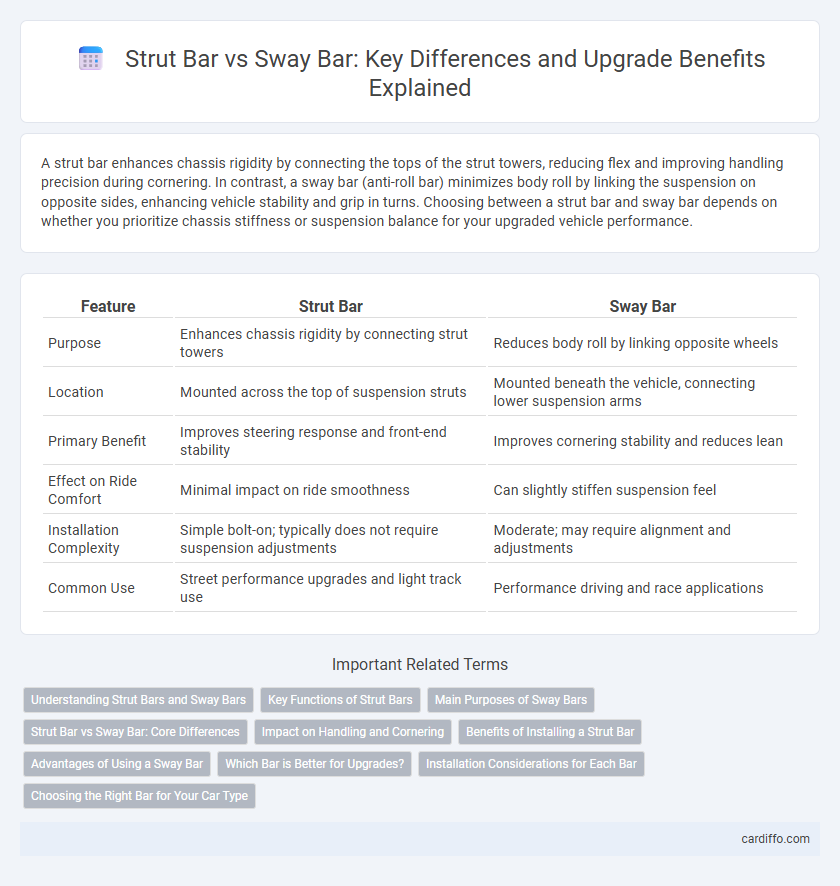A strut bar enhances chassis rigidity by connecting the tops of the strut towers, reducing flex and improving handling precision during cornering. In contrast, a sway bar (anti-roll bar) minimizes body roll by linking the suspension on opposite sides, enhancing vehicle stability and grip in turns. Choosing between a strut bar and sway bar depends on whether you prioritize chassis stiffness or suspension balance for your upgraded vehicle performance.
Table of Comparison
| Feature | Strut Bar | Sway Bar |
|---|---|---|
| Purpose | Enhances chassis rigidity by connecting strut towers | Reduces body roll by linking opposite wheels |
| Location | Mounted across the top of suspension struts | Mounted beneath the vehicle, connecting lower suspension arms |
| Primary Benefit | Improves steering response and front-end stability | Improves cornering stability and reduces lean |
| Effect on Ride Comfort | Minimal impact on ride smoothness | Can slightly stiffen suspension feel |
| Installation Complexity | Simple bolt-on; typically does not require suspension adjustments | Moderate; may require alignment and adjustments |
| Common Use | Street performance upgrades and light track use | Performance driving and race applications |
Understanding Strut Bars and Sway Bars
Strut bars enhance chassis rigidity by connecting the tops of the strut towers, reducing flex and improving handling precision during cornering. Sway bars, or anti-roll bars, link the left and right suspension components to minimize body roll by distributing weight more evenly across the tires. Both components optimize stability but target different aspects of vehicle dynamics for a balanced driving experience.
Key Functions of Strut Bars
Strut bars enhance vehicle chassis rigidity by connecting the top strut towers, reducing flex during cornering for improved handling precision. Unlike sway bars that primarily control body roll, strut bars maintain suspension geometry alignment, ensuring better tire contact and stability. Key functions include distributing chassis load evenly and minimizing torsional forces to optimize overall vehicle performance.
Main Purposes of Sway Bars
Sway bars primarily enhance vehicle stability by reducing body roll during cornering, ensuring better tire contact with the road for improved grip and handling. They work by linking opposite wheels via a torsion spring, distributing lateral forces more evenly across the suspension system. This upgrade is crucial for maintaining control and safety in sharp turns and aggressive driving conditions.
Strut Bar vs Sway Bar: Core Differences
Strut bars connect the two strut towers in a vehicle to reduce chassis flex and improve handling precision during cornering by distributing load more evenly across the front suspension. Sway bars, also known as anti-roll bars, link opposite wheels to minimize body roll and maintain tire contact with the road, enhancing stability in turns. The core difference lies in their function: strut bars primarily increase chassis rigidity, while sway bars control lateral body movement for better balance.
Impact on Handling and Cornering
Strut bars enhance handling by increasing chassis rigidity, reducing flex during cornering for improved steering precision and stability. Sway bars directly counteract body roll by linking opposite suspension components, allowing the vehicle to maintain better tire contact and balance through turns. Combining both upgrades optimizes cornering performance by stabilizing the chassis and minimizing lateral movement.
Benefits of Installing a Strut Bar
Installing a strut bar enhances chassis rigidity by connecting the strut towers, reducing flex during cornering and improving handling precision. This upgrade significantly boosts steering response and stability, especially in high-performance or aggressive driving conditions. Unlike sway bars that primarily control body roll, strut bars provide a direct improvement in suspension geometry and overall vehicle balance.
Advantages of Using a Sway Bar
A sway bar enhances vehicle stability by reducing body roll during cornering, improving overall handling performance. It connects opposite wheels to distribute weight more evenly, which increases traction and control on uneven or curved roads. Using a sway bar also promotes safer driving by maintaining better tire contact with the road surface, especially during high-speed maneuvers or sudden turns.
Which Bar is Better for Upgrades?
Choosing between a strut bar and a sway bar depends on your vehicle's handling goals and driving conditions. A sway bar, designed to reduce body roll during cornering, offers a more noticeable improvement in stability and overall handling performance for most upgrades. Strut bars primarily enhance chassis rigidity and can complement sway bars, but for aggressive driving or track use, the sway bar typically provides the better upgrade impact.
Installation Considerations for Each Bar
Strut bar installation typically requires access to the strut towers within the engine bay, often involving removing or repositioning components for proper fitment, which can be relatively straightforward on most vehicles. Sway bar installation involves connecting to the suspension's control arms and chassis, often requiring removal of wheels and suspension components, making it more complex and time-consuming than strut bars. Proper alignment and torque specifications are crucial for both bars to ensure safety and optimal performance during vehicle handling upgrades.
Choosing the Right Bar for Your Car Type
Strut bars enhance chassis rigidity by connecting the tops of the strut towers, making them ideal for cars with softer suspensions like daily drivers or front-wheel drives to improve handling precision. Sway bars reduce body roll by linking opposite suspension arms, offering better cornering stability for heavier vehicles and performance-oriented rear or all-wheel drive cars. Selecting the right bar depends on your car's suspension setup, driving style, and weight distribution to maximize handling and stability gains.
Strut bar vs Sway bar Infographic

 cardiffo.com
cardiffo.com